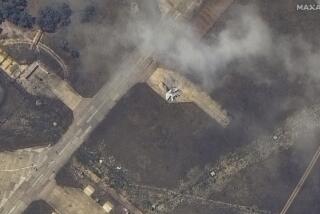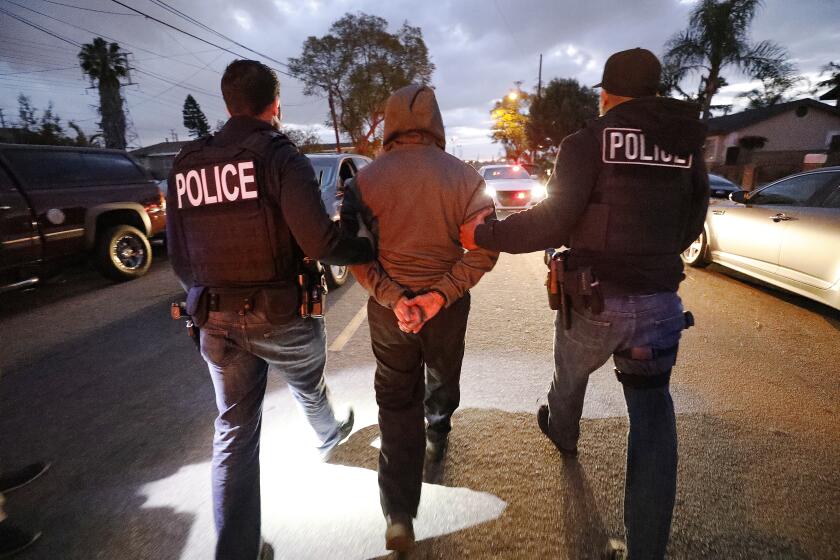An Army of Police Hunts Elusive Prey
No one has reported seeing the Washington Beltway killer in lethal action. No one can be certain of seeing him flee. He is more hunter than sniper, investigators say, a proficient rifleman intimate with suburban Washington’s nimbus of highways and malls. He picks out his lone quarry, fires from as far as 500 yards away, then vanishes on planned escape routes.
For 10 days, as the gunman stalked 10 victims in a metropolis of 5 million people, killing eight and wounding two, an unprecedented army of 200 detectives bolstered by hundreds of local patrol officers and federal agents has fanned out through Washington’s panicked suburbs. Northern Virginia authorities said Saturday that ballistic tests confirmed that Friday’s victim also was killed by the same sniper. Kenneth H. Bridges, a 53-year-old Philadelphia businessman, was felled by a distant shot at a gas station just off the highway near Fredericksburg.
Investigators have amassed evidence from dozens of witnesses, sifted through nearly 10,000 tips, logged thousands of hours and hundreds of thousands of dollars in overtime pay -- all in the futile search for a human cipher. In suburban Montgomery County, Md., where five victims were slain in a 16-hour spree 10 days ago, teams of detectives have spent hours pulling stacks of purchase orders and registration records at gun shops, trying to find a paper trail on the killer.
For all police know, there is so much more they do not. Except for several spent shells and bullet fragments and a cryptic calling card apparently left by the killer at one shooting site, physical evidence is meager.
Victims seem chosen by opportunity, not by design -- shrouding the killer’s motives. And stunned witnesses have offered a chaotic fog of observations, forcing hesitant investigators to operate mostly on theories, uncertain even whether they are pursuing one or two suspects.
“He chooses his victims with no discernible motive other than the kill,” said a senior law enforcement official working with the task force. “This is what hunters do.”
The card was drawn from a Tarot deck embossed with the skeletal symbol of death. A message scrawled on it, “Dear Mr. Policeman, I am God,” has been analyzed by experts who conclude that it came from the gunman.
But beyond the spectral card left near the Prince George’s County, Md., schoolyard where a 13-year-old was wounded, police have almost none of the crucial physical evidence -- license tags, receipts, clothing -- they desperately need to zero in on the killer’s neighborhood.
“He’s basically turning the region into his personal shooting gallery,” said James Alan Fox, an analyst of serial murders and a professor of criminal justice at Northeastern University in Boston. “And he’s enjoying it.”
Although investigators have spent recent days interviewing scores of Virginia motel guests in Manassas and Four Mile Fork on the possibility that the killer may have been a transient who rented a room, officials suspect the killer is more likely a Montgomery County resident with business or relatives in Virginia.
“A spree like this usually starts in a community they know,” one official said. “The small circumference” of the initial killings suggests the sniper lives somewhere in Maryland, the official said, then shifted to Virginia when police activity threatened his ability to move about freely.
Still, investigators have tried to take care not to narrow their focus. On Friday, hours after Bridges was killed, deputies detained Hobert Epps, 36, an Athens, Ga., man who wandered up to the yellow crowd control tape separating police from news crews.
Epps, a ruddy, barrel-chested man with a thick mustache, said he was searched, then taken to a motel room where investigators grilled him about his interest in the case. “They told me I fit the profile” of a suspect in the case, Epps said.
At one point, Epps said, police scrutinized his face, comparing it with a small, grainy photograph that appeared to have been magnified from a video camera. After several minutes, Epps said, he was freed.
Virginia authorities declined to say whether police were using any photos of suspects in the killing spree. But other officials said that local detectives and federal agents have been reviewing hours of video surveillance tapes shot from cameras overlooking crime scenes in Maryland and Virginia.
Late Saturday, the police task force released its first sketch of the elusive white box truck spotted more than a week ago by witnesses at suburban Maryland murder scenes. A similar sketch was also being readied showing a second white Chevrolet Astro van reported in the vicinity of the Friday slaying.
“We hope it will help people and prompt their memory,” said Montgomery County Police Chief Charles A. Moose, who heads the massive police team. Moose said several witnesses spotted the white box truck 10 days ago at “more than one location” in Maryland. There were other indications that the truck, with its distinctive dented bumper and un-deciphered lettering, had been spotted at three homicide sites.
In recent days, veteran FBI and federal Bureau of Alcohol, Tobacco and Firearms profilers have amassed detailed psychological and geographical portraits of the murderer and the patterns of the killing spree. But those portraits may have been redrawn in recent days as the killer shifted his pattern of attack.
Although Moose has declined to discuss the profilers’ work, he urged residents Saturday to report anyone “not at work during the incident,” keeping haphazard schedules or displaying “some sort of anger toward police.” One official said that sort of profile might fit a mobile contractor, such as a plumber or electrician, who uses a van or truck to circle the far-flung Beltway and its byways.
After an initial daring strike through the heart of suburban Montgomery County, squeezing off solitary rifle shots that killed five victims around the heavily traveled Connecticut Avenue corridor, the killer suddenly altered his tactics. Since Wednesday, he has killed two men at remote Virginia highway interchanges -- an apparent response, one official said, to the growing police presence on the Maryland side and also to detailed media accounts of his exploits.
“He’s random and methodical at the same time,” said Montgomery County State’s Atty. Douglas F. Gansler, who heads a team of prosecutors working on the first five Maryland killings.
But by choosing a disparate range of victims -- black, white and Asian, teenage and middle-age -- the killer sends no discernible hint of motive. “Nobody really knows what’s spurring him to do this,” Gansler said.
Virginia authorities seemed to back away late Friday from their earlier emphasis on the white van, conceding that witnesses only saw a vehicle driving away from the shooting scene, uncertain whether it was involved in the shooting.
But federal law enforcement sources said Saturday that witnesses from several of the sniper’s killing grounds have reported to investigators that they saw a white van weaving through traffic at the exact moment shots were fired. In other cases, such as the shooting at the middle school in Prince George’s County, Md., the gunman apparently staked out a prone position in the woods, firing from behind dense foliage.
If shots were fired from a moving vehicle, officials said, that might indicate not only that the shooter is adept, but also may have an accomplice driver.
A federal official said Saturday that teams of investigators are looking into three distinct theories about who their suspect might be. The suspect could be a solitary middle-age white male. He could also be a team of two, either dark-skinned Latinos or Middle Easterners, according to some witness accounts. And there are some witness reports suggesting that a male and female team drove off in the truck.
Police have not discussed those theories openly. But in one media interview last week, Gary M. Bald, an FBI agent from Baltimore who is coordinating the bureau’s involvement, acknowledged that investigators had information concerning the ethnicity and other details of those being sought.
But the wide variation in operating theories indicates the difficulty that witnesses have had in scanning a crime scene moments after hearing the crack of a gunshot and then providing reliable reports to police.
“The average suburban person has never heard a gunshot,” said Harry Geehreng, a former Montgomery County police sergeant. “Unless they’re in the police business or have some kind of training, they think it’s a backfire or noise from a construction site. Their first focus is on the victim, not the killer, and by the time they look around, the suspect is probably long gone.”
There have also been internal debates within the task force about the killer’s proficiency with his rifle. Officials said federal investigators have pored over military records, even seeking help from Pentagon officials in searching for records of former military snipers and crack marksmen for possible suspects.
But investigators and former police weapons experts have concluded that the killer’s level of expertise does not indicate high-level military weapons training. Instead, they believe he is either a hunter or someone who has taken enough rifle training to show limited proficiency -- and may be using a telescopic sight and a brace to steady his aim.
“He’s hitting his target, but the targets are not that difficult to hit,” said Stuart A. Meyers, a former Montgomery County police assault team sniper who now works as a weapons trainer. “With some basic training and aids like scopes, these are not impossible feats.”
The gunman, said one official, has been firing from as close as 150 yards and perhaps as far as 500 yards. In at least two killings, investigators are uncertain where the shooter fired from.
“That makes for an enormous expansion of these crime scenes,” the official said. That explains why police have cordoned off stretches of streets and raked over motel balconies, lots and shrubbery hundreds of yards from the killing zones.
ATF agents have used metal detectors and dogs capable of sensing the trace presence of firearms. On Friday, several of the animals, transported from the agency’s canine unit in Front Royal, Va., foraged through a grassy area no more than 50 yards from where Bridges fell. But even as they did, FBI agents across a remote stretch of U.S. 1 went door to door in several motels, questioning guests.
Detectives already have canvassed area gun shops in Maryland, a move Virginia authorities are now expanding in their own jurisdictions after last week’s sniper killings in Prince William and Spotsylvania counties.
As early as 10 days ago, hours after the fifth Maryland victim, Lori Ann Lewis-Rivera, 25, was shot dead at a Shell station, Montgomery County detectives swept into gun stores, poring through registration records and sales receipts.
“They wanted to know if anyone had bought a large amount of ammunition at one time,” said Hank Posner, manager of Gilbert Guns in Rockville. Detectives homed in on records showing that one customer recently bought 10 boxes -- more than 200 rounds -- of .223-caliber ammo. But several days later, police told Posner the patron had a legitimate explanation.
In the days since, several dozen Maryland gun shops have been searched. Virginia arms dealers said late Friday they soon expected a wave of visits from local investigators in the wake of the latest service station killings.
But despite the urge to check any lead, Meyers said gun record searches would have limited value. “This is not a unique weapons system he’s probably using,” he said. “Too many people use that ammunition and the guns that fire them.”
There are at least half a dozen varieties of weapons that fire the popular .223 rounds. One federal firearms investigator cited the AR-15, the semiautomatic civilian version of the fully automatic M-16 military rifle, as the most likely weapon used by the killer.
Maryland and Virginia prosecutors have sent top assistants out to crime scenes with investigators after each new incident. After the Prince William slaying, the county’s prosecutor said he would press for the death penalty if the sniper is captured. Although Maryland Gov. Parris Glendening has imposed a temporary moratorium on executions, Gansler -- the Montgomery County state’s attorney -- said that would not prevent him from also seeking to try the killings in his county as capital cases.
Prosecutors have researched the legal ramifications of some of the police team’s rapid moves. Before police moved to search white box trucks across the region’s roads, prosecutors had to “figure out if we could stop any white box truck out there,” Gansler said. Lawyers concluded that the extraordinary civic peril justified the move.
Former police officials and task force officials say the team is pressing every available resource.
On the one hand, the involvement of federal authorities has given the task force the ability to use the FBI’s advanced computerized collating of informant tips, detailed geographical plotting of the killer’s patterns and rapid ATF testing of bullet fragments.
At the same time, other officials say, local police chiefs are pressing patrol officers at daily roll calls to stay alert for the routine police work that could break the case.
In Montgomery County, the area’s 1,000-officer department is “already responding on the patrol level,” former police sergeant Geehreng said.
“I’ve seen them stopping white trucks all over the place.”
That attention to detail has sometimes led investigators to retrace each other’s tracks. But even the attendant chaos sometimes yields small victories.
On Friday, three hours after Bridges fell mortally wounded at the Exxon pump bay in Four Mile Fork, an ATF agent burst into a Waffle House down the hill from the murder scene.
Virginia troopers and sheriff’s deputies already had been through the restaurant several times, questioning waitresses, cooks and patrons. But the ATF agent persisted.
“Is there anybody who was here this morning who hasn’t been interviewed yet?” he asked.
When he noticed a waitress grimace, he motioned her to follow him behind a closed pantry door.
He left five minutes later, clutching an investigator’s notebook containing several newly filled pages.
*
Times staff writer Josh Meyer contributed to this report.
More to Read
Start your day right
Sign up for Essential California for news, features and recommendations from the L.A. Times and beyond in your inbox six days a week.
You may occasionally receive promotional content from the Los Angeles Times.






